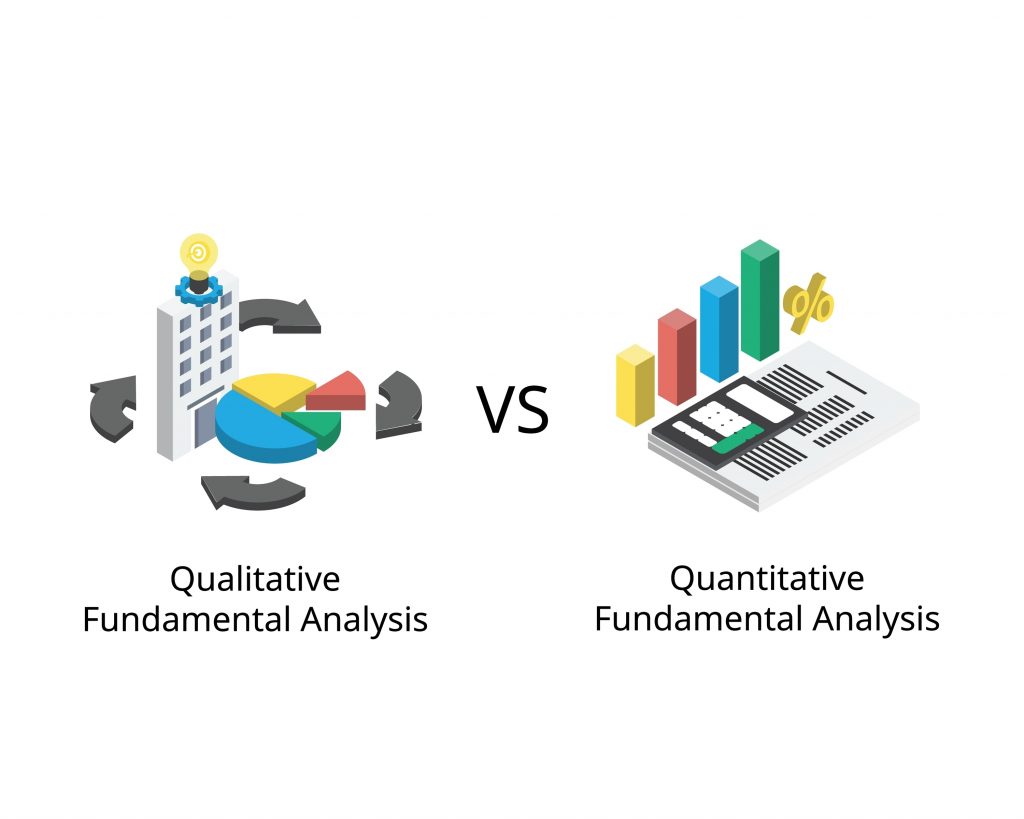
- Logo
- Ticker
- Company Name
- Exchange
- Previous close
How Qualitative Analysis Complements Quantitative Analysis | Invetso

Introduction
Understanding a company’s value requires more than just crunching numbers—it demands a blend of quantitative analysis and qualitative insights. Together, these two approaches form the foundation of Fundamental Analysis (FA), offering a complete picture of a company’s financial health, market positioning, and growth potential.
This article explores how qualitative analysis enhances quantitative metrics, why their combination is essential for fundamental analysis, and how platforms like Invetso simplify the process for better decision-making.
What is Fundamental Analysis?
Fundamental analysis evaluates a company’s intrinsic value by combining quantitative analysis (numerical data) with qualitative analysis (intangible factors). A well-rounded fundamental analysis considers both:
- Quantitative Factors: Financial statements, ratios, and measurable performance metrics.
- Qualitative Factors: Management quality, brand strength, competitive positioning, and market dynamics.
By integrating these elements, fundamental analysis provides a holistic view, helping to uncover opportunities and risks that numbers alone may not reveal.
Breaking Down Quantitative and Qualitative Analysis
Quantitative Analysis
Quantitative data focuses on measurable factors, typically drawn from financial statements and reports. Key metrics include:
- Revenue growth rates
- Profit margins
- Price-to-Earnings (P/E) ratio
- Debt-to-Equity ratio
These numbers allow you to evaluate a company’s financial health, operational efficiency, and performance trends.
Qualitative Analysis
Qualitative insights provide context to the numbers, evaluating intangible factors that impact a company’s success. Examples include:
- Leadership and management competence
- Industry and market trends
- Brand reputation and customer loyalty
- Competitive advantages and innovation potential
These elements often uncover risks and opportunities not immediately apparent in the financial data.
How Qualitative Analysis Enhances Quantitative Metrics
- Provides Context to Financial Data
Quantitative data reveals trends, but it doesn’t tell the full story. For instance:
- Strong revenue growth might appear positive, but qualitative analysis could reveal it’s driven by unsustainable discounting practices.
By examining the broader context, you can distinguish short-term gains from long-term opportunities.
- Highlights Intangible Risks and Opportunities
Financial statements alone may not capture hidden risks, such as poor leadership or declining customer sentiment, or emerging opportunities, like innovative technology. Qualitative analysis dives into these factors, ensuring no critical detail is overlooked.
- Supports Long-Term Decision-Making
While quantitative analysis often emphasizes short-term metrics, qualitative insights focus on sustainability and growth. For example:
- Evaluating a company’s competitive position or innovation potential can clarify its future prospects beyond current earnings reports.
- Completes Fundamental Analysis
A complete fundamental analysis depends on the integration of quantitative and qualitative factors. Without both, conclusions may be one-sided or incomplete.
How to Combine Qualitative and Quantitative Analysis
- Start with the Numbers
Use quantitative analysis to establish a baseline. Assess key metrics like revenue, debt levels, and profitability ratios to understand financial performance. - Add Depth with Qualitative Insights
Explore the factors behind the numbers. Look into management decisions, industry trends, and competitive strengths to gain deeper understanding. - Use Tools for Integration
Simplify the process with platforms like Invetso, which focuses on qualitative insights while complementing quantitative data, helping you uncover a company’s full potential.
Why This Approach Matters
Relying solely on numbers risks overlooking critical factors like leadership quality, market dynamics, and innovation potential. On the other hand, focusing only on qualitative factors may lack the objectivity and precision that financial data provides. By combining the two, you can achieve a balanced, informed perspective that forms the foundation of sound decision-making.
Key Takeaways
- Fundamental analysis requires both quantitative metrics (e.g., revenue and profit margins) and qualitative insights (e.g., leadership and competitive positioning).
- Quantitative analysis provides objective data, while qualitative analysis adds depth and context to interpret that data effectively.
- Platforms like Invetso focus on delivering actionable qualitative insights, simplifying the evaluation process and helping you uncover a company’s true potential.
🎯 Sign up for free today to unlock qualitative insights with Invetso for a complete understanding of your favorite companies.
Disclaimer: Invetso is not a financial advisor, and all information is provided solely for informational purposes.
You can continue reading
How Qualitative Analysis Complements Quantitative Analysis | Invetso

Introduction
Understanding a company’s value requires more than just crunching numbers—it demands a blend of quantitative analysis and qualitative insights. Together, these two approaches form the foundation of Fundamental Analysis (FA), offering a complete picture of a company’s financial health, market positioning, and growth potential.
This article explores how qualitative analysis enhances quantitative metrics, why their combination is essential for fundamental analysis, and how platforms like Invetso simplify the process for better decision-making.
What is Fundamental Analysis?
Fundamental analysis evaluates a company’s intrinsic value by combining quantitative analysis (numerical data) with qualitative analysis (intangible factors). A well-rounded fundamental analysis considers both:
- Quantitative Factors: Financial statements, ratios, and measurable performance metrics.
- Qualitative Factors: Management quality, brand strength, competitive positioning, and market dynamics.
By integrating these elements, fundamental analysis provides a holistic view, helping to uncover opportunities and risks that numbers alone may not reveal.
Breaking Down Quantitative and Qualitative Analysis
Quantitative Analysis
Quantitative data focuses on measurable factors, typically drawn from financial statements and reports. Key metrics include:
- Revenue growth rates
- Profit margins
- Price-to-Earnings (P/E) ratio
- Debt-to-Equity ratio
These numbers allow you to evaluate a company’s financial health, operational efficiency, and performance trends.
Qualitative Analysis
Qualitative insights provide context to the numbers, evaluating intangible factors that impact a company’s success. Examples include:
- Leadership and management competence
- Industry and market trends
- Brand reputation and customer loyalty
- Competitive advantages and innovation potential
These elements often uncover risks and opportunities not immediately apparent in the financial data.
How Qualitative Analysis Enhances Quantitative Metrics
- Provides Context to Financial Data
Quantitative data reveals trends, but it doesn’t tell the full story. For instance:
- Strong revenue growth might appear positive, but qualitative analysis could reveal it’s driven by unsustainable discounting practices.
By examining the broader context, you can distinguish short-term gains from long-term opportunities.
- Highlights Intangible Risks and Opportunities
Financial statements alone may not capture hidden risks, such as poor leadership or declining customer sentiment, or emerging opportunities, like innovative technology. Qualitative analysis dives into these factors, ensuring no critical detail is overlooked.
- Supports Long-Term Decision-Making
While quantitative analysis often emphasizes short-term metrics, qualitative insights focus on sustainability and growth. For example:
- Evaluating a company’s competitive position or innovation potential can clarify its future prospects beyond current earnings reports.
- Completes Fundamental Analysis
A complete fundamental analysis depends on the integration of quantitative and qualitative factors. Without both, conclusions may be one-sided or incomplete.
How to Combine Qualitative and Quantitative Analysis
- Start with the Numbers
Use quantitative analysis to establish a baseline. Assess key metrics like revenue, debt levels, and profitability ratios to understand financial performance. - Add Depth with Qualitative Insights
Explore the factors behind the numbers. Look into management decisions, industry trends, and competitive strengths to gain deeper understanding. - Use Tools for Integration
Simplify the process with platforms like Invetso, which focuses on qualitative insights while complementing quantitative data, helping you uncover a company’s full potential.
Why This Approach Matters
Relying solely on numbers risks overlooking critical factors like leadership quality, market dynamics, and innovation potential. On the other hand, focusing only on qualitative factors may lack the objectivity and precision that financial data provides. By combining the two, you can achieve a balanced, informed perspective that forms the foundation of sound decision-making.
Key Takeaways
- Fundamental analysis requires both quantitative metrics (e.g., revenue and profit margins) and qualitative insights (e.g., leadership and competitive positioning).
- Quantitative analysis provides objective data, while qualitative analysis adds depth and context to interpret that data effectively.
- Platforms like Invetso focus on delivering actionable qualitative insights, simplifying the evaluation process and helping you uncover a company’s true potential.
🎯 Sign up for free today to unlock qualitative insights with Invetso for a complete understanding of your favorite companies.
Disclaimer: Invetso is not a financial advisor, and all information is provided solely for informational purposes.
You can continue reading
Unlock exclusive Perks
Be part of a select group and enjoy exclusive benefits reserved only for our Premium members.

- Logo
- Ticker
- Company Name
- Exchange
- Previous close
Updated: November 24, 2025
We have not found the stock you are looking for


